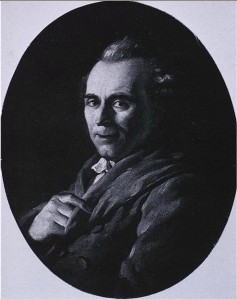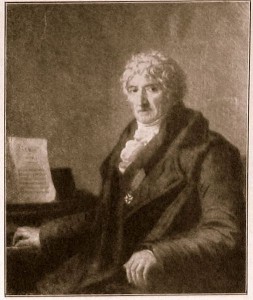Saturday, February 5th 230 AM
Last week I made a few notes about Ange-Jacques Gabriel, the architect of the opera house at Versailles. Gabriel had mastered one style (the voluptuous Rococo of Louis XV) and created a new one (the opulent classicism of Louis XVI). Towards the end of his career he rejected the sinuous and undulating decorations of the Rococo for fluted columns and the rectangle. Gabriel celebrated the entitlement of aristocracy and his style change was not a political comment, not a revolution in that sense. Had he lived longer his head would have found itself in the same basket as Richard Mique’s, his follower and architect to Marie Antoinette. Mique designed the new Queen’s peasant village and little theater.

But the stripping away of Rococo excesses by the librettist Michel-Jean Sedaine (1719-1797) and the composer, Pierre-Alexandre Monsigny (1729-1817) has more of a revolution even if it was unrecognized as such at court. Sedaine turned away from the past, from Racine and Corneille. The world of classical kings and heroines was of no interest to him and the ethic of courtly composure and checked passions is crumpled up into balls of paper and thrown into his poubelle (trashcan). Sedaine takes us into the world of the rustic hero and the sentimental heroine. His language is common and his humor, though sometimes reminiscent of Moliere, is not sharp, fine and probing but rather large-boned and gruff. This is the stuff of music hall entertainment. Courtiers are humiliated and ridiculed. The brilliance of the King is even questioned though his goodness taken as a given and his person, loved. Unlike the courtiers in Les Liaisons Dangereuses, the courtiers of Sedaine are not monsters and personages of subtle evil. Choderlos de Laclos’ Mons. Valmont and Mme. Merteuil seduce and then destroy you. The villains in Le Roi et le fermier are cartoon figures. You hear them coming from a mile away and chuckle as you flee their villainy.
Denis Diderot, one of Paris’ greatest critics of everything but particularly art, said that François Boucher was the greatest living painter but so dishonest. He praised the prudish morality and sentimentality of Jean-Baptiste Greuze. He felt secure in a world of earth tones, of browns and whites and probably abused by the endless rainbow and unchecked eroticism of Boucher. In many ways, the comparison of Greuze to Boucher is like the relationship between Pierre-Alexandre Monsigny and Jean Philippe Rameau (1688-1746). The music of Monsigny rejects the rococo excesses of Rameau and comes up with a music that is made of simpler stuff.

An opera of Rameau begins with a French overture, grand, complex, steeped in tradition. An overture of Monsigny is a modern fanfare and allegro. Simple and clear energy replaces learned, demanding tradition. A Rameau opera has one grand aria for each act. A Monsigny opera is a string of popular songs. A Rameau opera is made of rhetorical, recitatives, complex singing accompanied by the continuo section. Monsigny’s theater form allows the actors to talk their parts, doing away entirely with the recitatives that plunged Marie Antoinette into a deep princesses’ sleep on May 16, 1770 at the inauguration of the opera house when she attended a performance of Persée, a Lully tragedie-lyrique. Rameau lives up to the entitled eroticism of Boucher’s paintings with dance music that celebrates corporal beauty. Monsigny leaves out dance and seems a prude by comparison.
What Monsigny does offer is music for the new city of Paris, and ultimately, the new world of the middle class. Each aria is immediately attractive and accessible. Artifice does not conceal intention and the emotional message is front and center. Critics of Rameau complained that there was enough music in one of his stage works for 10 operas. Only 20 years later, Joseph II would exclaim of Mozart’s Marriage of Figaro, that there was too much music. But in between these two giants of the opera stage, Monsigny and Sedaine give us an experience of theater that successfully puts an end to the Old Regime form that no longer spoke to anyone, not even the most elevated families of Versailles, and launches into a direct and honest world of common human experience. REC SESSION Bill Sharp




Andy, I just read the whole palace series and feel transported and uplifted. Thank you for a beautiful morning visit to Versailles and the Opera Royal. And congratulations to Opera Lafayette!